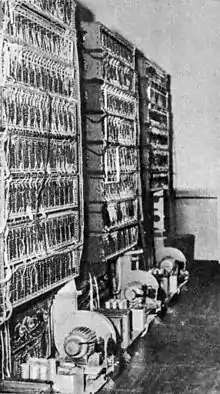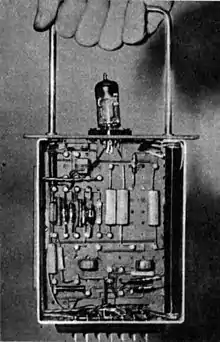.jpg.webp)
XYZ was the first Universal Digital Machine from the family of early computers built and launched in Poland in 1958. It was ahead of EMAL2 by a few months, while the earlier EMAL was not fully launched.[1]
Construction
XYZ computer was built and launched in Warsaw at ul. Śniadeckich 8, at the premises of the Bureau of Calculations and Programs of the Mathematical Apparatus Department of the Polish Academy of Sciences (later the Institute of Mathematical Machines).[2] The team was led by professor Leon Łukaszewicz.
XYZ was a laboratory model of a utility machine; the ZAM-2 series was created on the basis of this computer.[1]
The logical organization was modeled on the simplified IBM 701, but the electronics were based on the dynamic flip-flops of the M-20 machine, requiring twice as few lamps. The design of the flip-flops and gates was derived from EMAL, but the vacuum diodes were replaced with germanium ones. The working memory was also derived from the EMAL machine after the improvement.[1] It was a dynamic serial computer that computes in binary arithmetic.
The machine initially had no permanent memory, only RAM based structurally on ultrasound delay in a mercury-filled tubes. It was later expanded with a drum memory, an input-output system implemented through a primitive control console and a card reproducer (later a tape reader/perforator).
The basic fields of use of XYZ were mathematical calculations, and artillery conversion factors for the needs of the army.[3] Programmer Bogdan Miś wrote a program for entertainment on it in 1960 - a tic-tac-toe game, using an oscilloscope to present the course of the game. XYZ led to his own win or a draw, because the program includes all the strategies for its conduct.[4] Another demonstrative program written for XYZ was an animation of a dog peeing on a tree (also shown on the oscilloscope screen) created for the visit of the film crew, creating material about the first Polish computer.[3]
Specifications


- Organization:
- speed:
- 650–4500 additions per second (approximately 1000 average)
- 250–500 multiplications per second (350 average)[1]
- Clock generator: approx. 680 kHz[6]
- memory:
- mercury working memory:
- capacity: 2.25 KiB - 512 words (32 pipes of 576 bits)
- average access time : 0.4 ms
- drum
- fixed heads
- capacity: 36 KiB (64 tracks of 128 words)
- average access time: 20 ms[6]
- mercury working memory:
- External devices: reader and perforator card
- Technology: 400 electron tubes and 2000 diodes
Programming languages
References
Article was partially translated from Polish wiki article, for original see pl:XYZ.
- 1 2 3 4 Konstrukcje polskie: XYZ, Empacher A.B., Maszyny liczą same? / Adam B. Empacher / Katalog HINT, Wiedza Powszechna, 1960, s. 114-122 (in Polish)
- ↑ Leon Łukaszewicz: Automatyzacja oprogramowania w Polsce do roku 1970 w: Informatyka 3/1971 s. 2
- 1 2 Bartłomiej Kluska, Bartosz Rozwadowski: Bajty polskie. Sosnowiec: 2014, s. 3. ISBN 978-83-927229-2-2.
- ↑ Marcin Kosman: Nie tylko Wiedźmin. Historia polskich gier komputerowych. Warszawa: Open Beta, 2015, s. 21. ISBN 978-83-941625-0-4.
- ↑ Janusz Groszkowski: 'A few words on the occasion of the Jubilee of the Institute of Mathematical Machines', Informatyka no. 3/1973
- 1 2 3 "XYZ – pierwsza polska elektronowa maszyna cyfrowa / Stanisław Majerski, Antoni Mazurkiewicz / Katalog HINT". hint.org.pl. Retrieved 24 November 2021.
- ↑ Leon Łukaszewicz: Software automation in Poland until 1970 in: Informatyka 3/1971 p. 6, tab. "Implementation of higher-level languages and some operating systems in Poland in 1958—1970"
External links
- Photo and description
- PTI Historical Section, Short description of the XYZ-I programmable digital machine, historiainformatyki.pl
